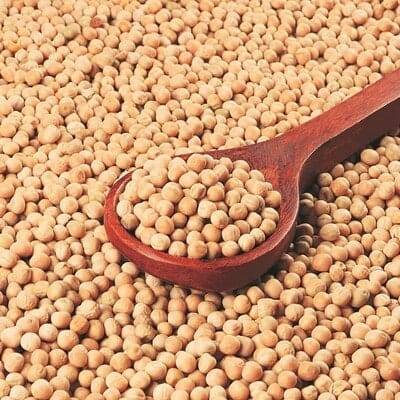Main Points In Hindi (मुख्य बातें – हिंदी में)
-
बेसन में पीली मटर का मिश्रण: भारतीय बेसन, जो प्रीमियम चना दाल से बनाया जाता है, को सस्ते पीले मटर के साथ मिलाकर बनाया जा रहा है, जिसके चलते पारदर्शिता और कीमतों में वृद्धि पर चिंता व्यक्त की जा रही है।
-
कीमतों में असमानता: जबकि पीली मटर की लागत ठेके पर 35 रुपये प्रति किलोग्राम है, चना दाल की कीमत लगभग 74 रुपये प्रति किलोग्राम है। इसके बावजूद, बेसन की कीमत 110 रुपये प्रति किलोग्राम तक बढ़ गई है, जिससे यह सवाल उठता है कि निर्माता उपभोक्ताओं को लाभ नहीं पहुँचा रहे हैं।
-
सरकारी ध्यान और नियम: सरकार बेसन में पीली मटर के उपयोग की सीमा निर्धारित करने के लिए परीक्षण कर रही है, और नए नियम लाने की योजना बना रही है जिससे निर्माताओं को सामग्री के बारे में जानकारी देना अनिवार्य होगा।
-
दाल आयात में वृद्धि: भारत में दाल का आयात इस साल छह साल के उच्चतम स्तर पर पहुँच गया है, जिनमें प्रमुखता से पीली मटर का आयात किया गया है, जिसकी लागत-प्रभावशीलता इसे लोकप्रिय बना रही है।
- महंगाई का प्रभाव: दालों की बढ़ती मांग और उत्पादन में बदलाव के कारण भारत में खाद्य पदार्थों की कीमतें बढ़ रही हैं, जिससे शाकाहारी भोजन की कुल लागत में अप्रैल से सितंबर 2024 तक 14% की बढ़ोतरी हुई है।
Main Points In English(मुख्य बातें – अंग्रेज़ी में)
Here are the main points from the text:
-
Substitution of Ingredients: Indian besan, traditionally made from premium chana dal, is increasingly being mixed with cheaper yellow peas, raising concerns about transparency as manufacturers continue to sell besan at high prices despite the cost-effective substitution.
-
Price Discrepancy: While yellow peas are sold at approximately ₹35 per kilogram, chana dal averages ₹74 per kilogram. Despite this, the retail price of besan has risen to ₹110 per kilogram, causing worries that consumers are not benefiting from cost savings.
-
Government Regulation and Testing: To address this issue, government agencies are testing besan samples to determine the extent of yellow pea usage and are expected to guide manufacturers to lower their prices accordingly.
-
Increased Imports and Production Impact: The Indian government has declared yellow peas as duty-free to stabilize food inflation, leading to a significant increase in imports. However, this has discouraged local farmers from cultivating pulses, potentially impacting domestic production negatively.
- Rising Prices of Pulses: Due to increased demand for pulses and changes in production, food prices in India have risen, with a notable 14% increase in dal prices this year, contributing to higher overall vegetarian food costs in households.


Complete News In Hindi(पूरी खबर – हिंदी में)
भारतीय बेसन, या बेसन, जो परंपरागत रूप से प्रीमियम चना दाल (बंगाल चना) से बनाया जाता है, को सस्ते पीले मटर के साथ तेजी से मिलाया जा रहा है, एक रिपोर्ट के अनुसार पुदीना. इस मुद्दे ने पारदर्शिता और निष्पक्षता को लेकर चिंताएं बढ़ा दी हैं क्योंकि निर्माता इस प्रतिस्थापन के बावजूद बेसन को ऊंची कीमतों पर बेचना जारी रख रहे हैं।
जबकि पीली मटर उपभोग करने के लिए सुरक्षित है और चना दाल का एक व्यवहार्य विकल्प हो सकती है, वे लगभग 35 रुपये प्रति किलोग्राम की बहुत सस्ती कीमत पर खुदरा बिक्री करते हैं, जबकि चना दाल की कीमत औसतन 74 रुपये प्रति किलोग्राम हो सकती है। पीली मटर चना दाल की कीमत से आधे से भी कम होने के बावजूद, बेसन की खुदरा कीमत 110 रुपये प्रति किलोग्राम बढ़ी हुई है, जिससे यह चिंता पैदा हो गई है कि निर्माता उपभोक्ताओं को बचत न देकर अत्यधिक मुनाफा कमा रहे हैं।
पीली मटर के साथ मिश्रित बेसन की कीमत आदर्श रूप से 50 रुपये प्रति किलोग्राम से कम होनी चाहिए, लेकिन यह समायोजन अभी तक बाजार में दिखाई नहीं दिया है। इस मुद्दे को हल करने के लिए, सरकारी एजेंसियां पीली मटर के उपयोग की सीमा निर्धारित करने के लिए बेसन के नमूनों का परीक्षण कर रही हैं और उम्मीद है कि वे निर्माताओं को तदनुसार अपनी कीमतें कम करने का निर्देश देंगी।
पीली मटर का शुल्क मुक्त आयात
2023 के अंत में भारत सरकार द्वारा पीली मटर को शुल्क-मुक्त घोषित किया गया, जिससे आयात में वृद्धि हुई। दाल के आयात को जुलाई 2024 तक शुल्क-मुक्त रहने की अनुमति दी गई थी, जिसे बाद में अक्टूबर 2024 तक बढ़ा दिया गया था। इसकी लागत-प्रभावशीलता के कारण, यह कथित तौर पर बेसन उत्पादन में एक लोकप्रिय विकल्प बन गया है।
प्रारंभ में खाद्य मुद्रास्फीति को स्थिर करने के लिए शुरू की गई सस्ती (आयातित) पीली मटर की आमद ने स्थानीय किसानों को चना और अरहर जैसी दालें उगाने से हतोत्साहित कर दिया है। पिछले वर्ष पीली और हरी मटर का कुल उत्पादन लगभग दस लाख टन होने का अनुमान है, आयात की अधिक मात्रा के कारण इस आंकड़े में और गिरावट आने की उम्मीद है।
भारत का दाल आयात छह साल के उच्चतम स्तर पर पहुंच गया
भारत का दाल आयात भी इस साल अप्रैल में छह साल के उच्चतम स्तर पर पहुंच गया, जो पिछले साल की समान अवधि की तुलना में 84 प्रतिशत बढ़ गया। आयात वृद्धि का नेतृत्व मुख्य रूप से लाल मसूर और पीली मटर ने किया, इसके बाद काले चने ने, जैसा कि पहले रिपोर्ट किया गया था बिजनेस स्टैंडर्ड.
अगस्त में इंडिया पल्सेस एंड ग्रेन्स एसोसिएशन (आईपीजीए) के अध्यक्ष बिमल कोठारी ने कहा कि वित्तीय वर्ष 2023-24 (FY24) में, अनाज को शुल्क मुक्त घोषित किए जाने के बाद से भारत ने रिकॉर्ड दो मिलियन टन पीली मटर का आयात किया। उन्होंने कहा कि कैलेंडर वर्ष 2024 के अंत तक 1-1.5 मिलियन टन और आने की उम्मीद है।
सरकार एमएफजी के लिए नए नियम लाएगी
सरकार नए नियमों पर काम कर रही है जिसके तहत निर्माताओं को बेसन में इस्तेमाल होने वाली सामग्री का खुलासा करना होगा। पुदीना सूचना दी. इस पहल का उद्देश्य यह सुनिश्चित करना है कि जब चना दाल के स्थान पर सस्ती पीली मटर का उपयोग किया जाए तो उपभोक्ताओं को कम कीमतों का लाभ मिले। भारतीय खाद्य सुरक्षा और मानक प्राधिकरण (एफएसएसएआई) भी बेसन बाजार में इन लेबलिंग मानकों को लागू करने में शामिल होगा।
महंगाई और बढ़ती खाद्य कीमतें
उत्पादन में इस बदलाव और दालों की बढ़ती मांग ने भारत में खाद्य पदार्थों की ऊंची कीमतों में योगदान दिया है। क्रिसिल की एक हालिया रिपोर्ट में इस बात पर प्रकाश डाला गया है कि दाल की कीमतें, जो एक सामान्य शाकाहारी भोजन की लागत का लगभग 9 प्रतिशत है, इस साल 14 प्रतिशत बढ़ी है। सितंबर 2024 में भारतीय घरों में शाकाहारी भोजन की कुल लागत भी पिछले वर्ष की समान अवधि की तुलना में 11 प्रतिशत बढ़ गई। साल की शुरुआत में दालों के कम घरेलू उत्पादन और कम स्टॉक स्तर के कारण कीमतों में और बढ़ोतरी हुई है।
पहले प्रकाशित: अक्टूबर 07 2024 | दोपहर 1:20 बजे प्रथम
Complete News In English(पूरी खबर – अंग्रेज़ी में)
Indian gram flour, or besan, traditionally made from premium chickpeas, is increasingly being mixed with cheaper yellow peas, according to a report by Pudina. This shift has raised concerns about transparency and fairness, as producers continue to sell besan at high prices despite the substitution.
While yellow peas are safe to consume and can be a viable alternative to chickpeas, they retail for around ₹35 per kilogram, significantly cheaper than chickpeas, which average ₹74 per kilogram. Despite yellow peas costing less than half the price of chickpeas, the retail price of besan has increased to ₹110 per kilogram, raising worries that producers are profiting excessively without passing any savings to consumers.
The price of besan mixed with yellow peas should ideally be under ₹50 per kilogram, but this adjustment has not yet been seen in the market. To address this issue, government agencies are testing samples of besan to determine the amount of yellow peas used, hoping to instruct manufacturers to lower their prices accordingly.
Duty-Free Import of Yellow Peas
At the end of 2023, the Indian government declared yellow peas duty-free, leading to an increase in imports. The exemption on pulse imports was allowed to remain duty-free until July 2024, which was later extended to October 2024. Due to its cost-effectiveness, yellow peas have reportedly become a popular choice in besan production.
The influx of cheap imported yellow peas, initially aimed at stabilizing food inflation, has discouraged local farmers from growing pulses like chickpeas and arhar. In the past year, the total production of yellow and green peas was estimated to be around one million tons, and this figure is expected to drop further due to the high volume of imports.
India’s Pulse Imports at a Six-Year High
In August, Bimal Kothari, president of the India Pulses and Grains Association (IPGA), stated that India recorded a record two million tons of yellow peas imported since the grains were declared duty-free in the financial year 2023-24 (FY24). He mentioned that an additional 1-1.5 million tons are expected by the end of calendar year 2024.
Government to Introduce New Regulations for MFG
The government is working on new regulations requiring manufacturers to disclose the ingredients used in besan. According to Pudina, this initiative aims to ensure that consumers benefit from lower prices when cheaper yellow peas are used instead of chickpeas. The Food Safety and Standards Authority of India (FSSAI) will also be involved in implementing these labeling standards in the besan market.
Inflation and Rising Food Prices
The shift in production and the rising demand for pulses have contributed to high food prices in India. A recent report by Crisil highlighted that pulse prices, which account for about 9% of the cost of a typical vegetarian meal, increased by 14% this year. In September 2024, the total cost of vegetarian meals for Indian households also rose by 11% compared to the same period last year. Prices have been driven up due to lower domestic production and stock levels of pulses at the beginning of the year.
Originally published: October 07, 2024 | 1:20 PM First




